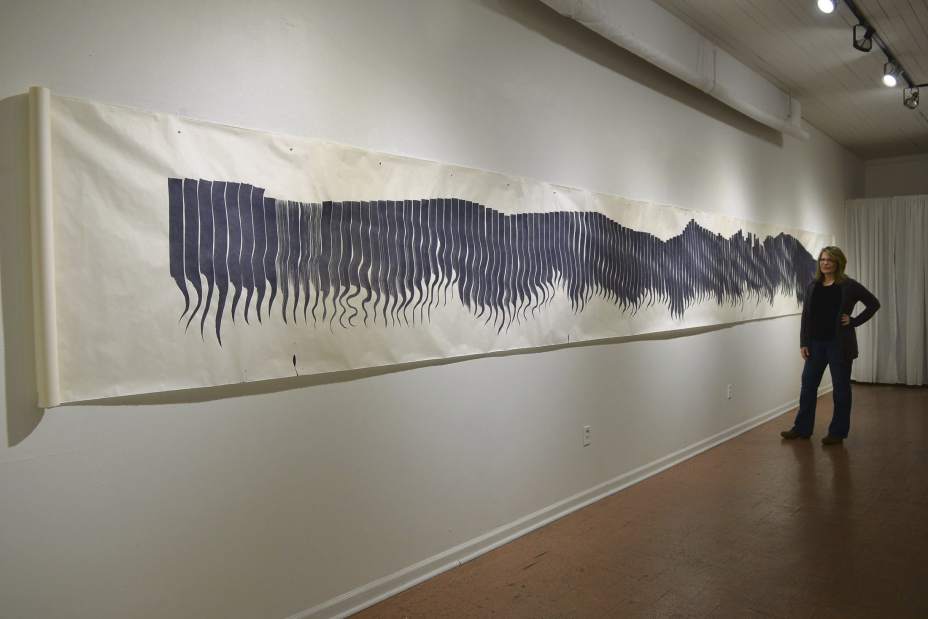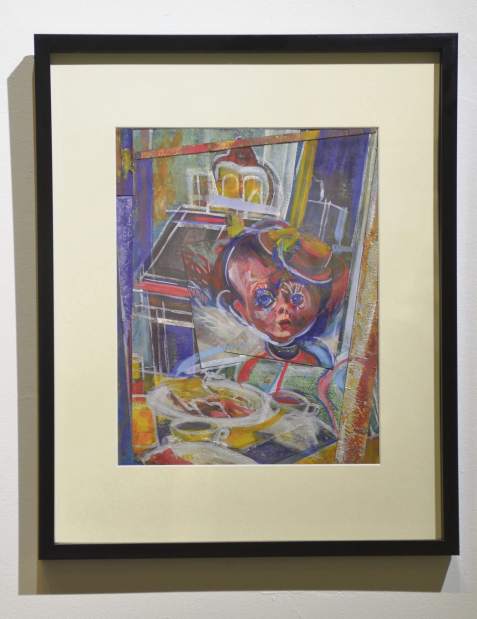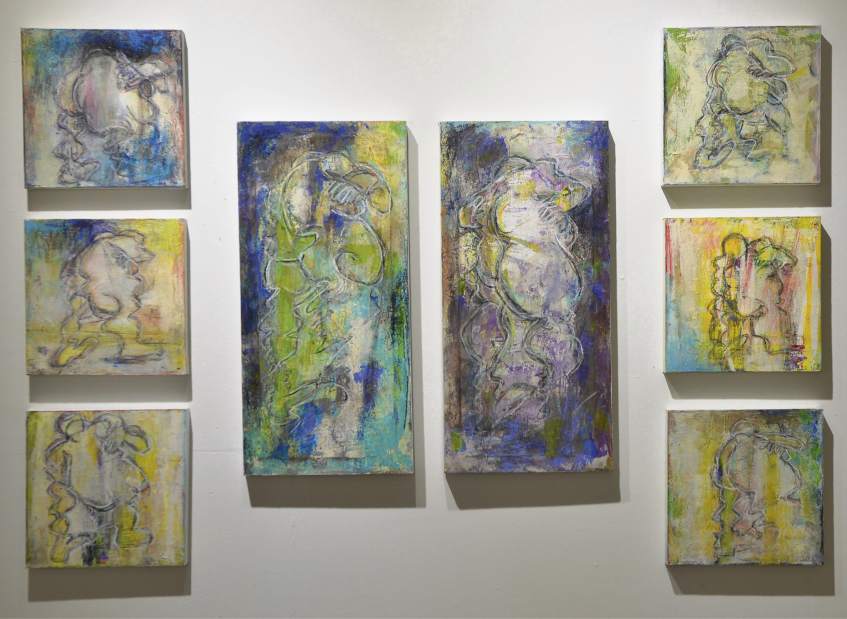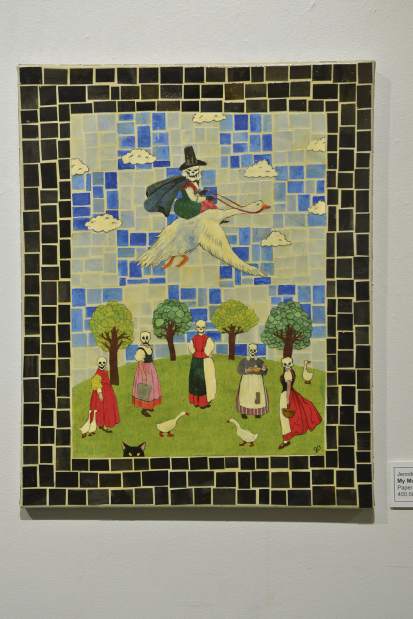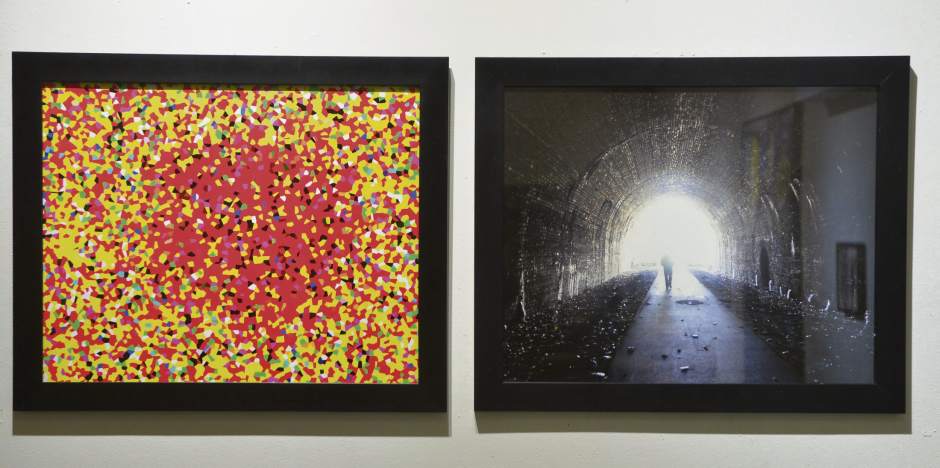Group A showing in Millvale represents variety of mediums, artistic interpretations
Originally known as the Abstract Group when it was founded in the 1950s, Group A has since not only changed its name, but also its focus. Now a wider variety of artistic interpretations are encouraged among its members. And that's exactly what you get with “Future/Present,” the group's latest exhibit, on display at Panza Gallery in Millvale.
This year, the juror was artist, puppeteer and educator Tom Sarver, who selected a diverse group of works that, as he writes in his statement, “demonstrate accomplishment and innovation in many traditional mediums, including oil paint, pen and ink and watercolors.”
That's certainly the case with the work of Theresa Antonellis of Grove City. Her piece, “Breathing Meditation,” shows that a lot can be made from a simple concept and materials.
A 24-foot-long mulberry paper scroll, it is filled with vertical brushstrokes painted with handmade oak-gall ink.
“This method came to me at a time when I wanted to find a way to merge art and yoga,” Antonellis says. “Around the same time, it became known my father was dying. Everyone who has lost a loved one knows how the mind obsessively searches for meaning and confronts loss. I was saying to myself, ‘I am breathing. I have this moment.' But then that breath is gone, and there's no record of it. So I started recording my breathing, one breath, one line, one breath, one line. And that grew to include the meditative aspect of breathing.”
If you've ever been to a yoga class with a knowledgeable yoga teacher, they will instruct you to move into the pose with the breath, to expand on the inhale and contract on the exhale.
“Reaching my hand up to the top of the paper is expansive, so that naturally pairs with the inhale.” Antonellis says. “Drawing my arm down is a contraction and goes with the exhale. Working in this method allows me to be meditative, and to construct a physical and visual record of breathing meditation. I paint one line per one breath. During the exhale, I pace the movement to match the breath and move according to the breath and range of motion in my arm. Whether I'm painting or drawing, I focus my attention on the physical action and on the energy of the breath. … The breath, the physicality of the experience in the present moment, is transferred to the paper without censorship.”
Mary Weidner of Fox Chapel displays two gouache paintings — “South Beach Male” and “Break Fast.” The latter is not only a gouache painting, but also includes bits and pieces collaged from previous paintings.
“Like much of my current work, it deals with the quirks and complexities of family life,” Weidner says. “Gouache itself is relatively new to me; it's similar to watercolor in that it can be quite transparent, but also allows for opaque layering, as in oil and acrylic paintings.”
Weidner says “Break Fast” is intentionally spelled as two words here.
“Many of us eat breakfast in a home setting, which can be peaceful if alone, or more chaotic on weekends,” she says. “The collage elements are taken from several other paintings, which have been cut apart, and then rearranged. … It was only when I cut it up, moved around parts, worked the color more spontaneously and added the doll's head that I captured the mood and complex memories I wanted.”
Another collage on display, “My Mother Goose” by Jennifer Dinovitz of Green Tree, is the result of similar experimentation.
“My work starts with color, the color of the squares around the edge and the squares in the background,” Dinovitz says. “These are hand-painted and cut by myself, and I have them separated in small bins.”
After these squares are glued down, Dinovitz says she usually finds an image from a book that catches her eye. “I'll move objects around, overlap, try things out ... a lot of experimenting goes into it before I actually glue it all together,” she says. “I will hand color or manipulate the cutouts to work together. ... It is this process I love.”
This particular image started as the title implies, from something she found in children's storybook. As to why each figure has a skull instead of a face, she says, “Dealing with abandonment issues has left me with a never-ending attraction to feeling somewhat comfortable in negative things, like when you hear ‘Think positive!' or ‘Put on a happy face!' That is not reality. It was not my reality, ever.
“My reality has been warped. I was told as an adolescent living on my own, ‘I am lucky to be sleeping on a mattress on the floor,' or how when I was hungry how ‘grateful I should be to be able to get expired lunchmeat from the food bank!' Many, many things I was told were ‘positive' but really were quite sad. ... No one cared about me. ... Was I really lucky?”
Also having a somber subtext, the grouping of abstract paintings, “Bad Genes” by Janice Schuler of Millvale, was made to illustrate what it might feel like “to struggle through a day, an hour” with addiction, the artist says.
“An old Alcoholics Anonymous slogan says, ‘One day at a time,' ” Schuler says. “For the person with a brain disease, getting through 10 minutes could be harrowing.”
The figure in these panels is from a drawing session at the gallery. It is a blind contour drawing, and you see the general posture of the figure, but not details. In this way, Schuler says, “I leave only indicators of the disease — humped-over posture, head down while dredging gait in no particular direction, floppy bodies with arms and legs that feel like jelly, uncontrollable movements in the limbs, bloated bellies.
“I believe addiction is a disease,” Schuler says. “It is not risky behavior. It is not a series of bad decisions. It is like diabetes, or cancer, or any potentially fatal disease.”
Then there is the work of Lawrenceville-based photographer Bill Wade. His piece “A Broken World and Hope for the Future” is a diptych that features an abstract mosaic and an image of a man walking through a tunnel.
Having worked on a series of abstract photographs for about eight years now, Wade says this is the first time that he has combined one of them with his documentary work.
The right image is a photograph from his “Portals and Passageways” series. “The image of someone walking toward the light represents my positive thoughts of hope for the future,” Wade says. “This series was done over a several-year period, where I attempted to show in photographs my feelings or mood at the time.”
Kurt Shaw is the Tribune-Review art critic. Reach him at tribliving@tribweb.com.

